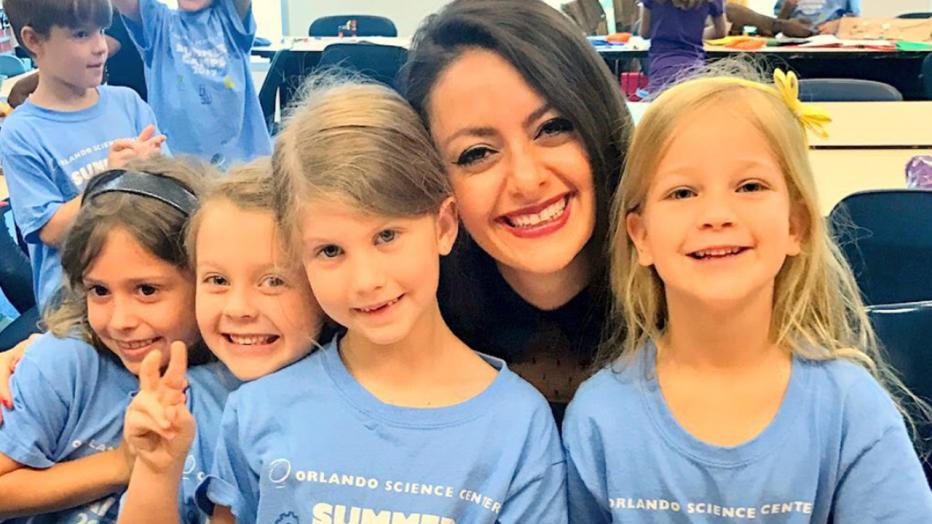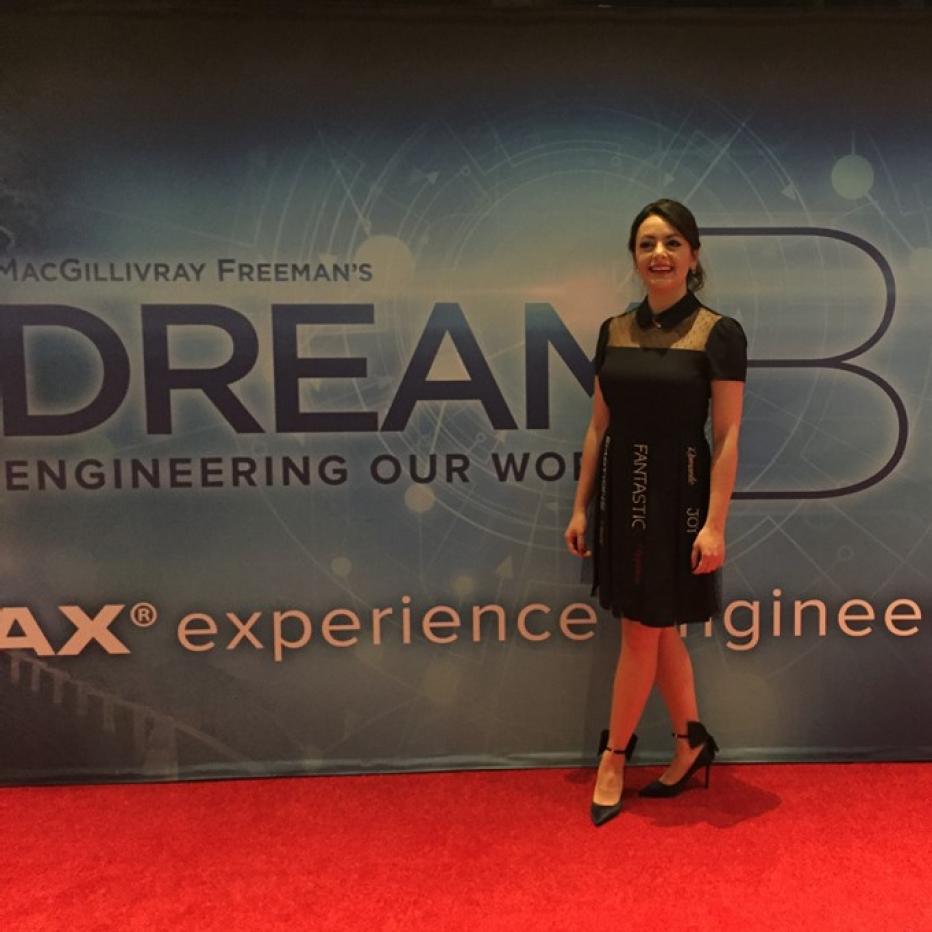
Geotechnical engineer Menzer Pehlivan from our Seattle office recently gave the keynote speech, “The Next Generation to Change the World” at the STEM Academy conference in New York.
Menzer, who once aspired to be an actress, turned dream into reality as the star of the film Dream Big: Engineering Our World, which takes viewers on a journey of discovery from the world’s tallest building to a bridge higher than the clouds, showing more than the ingenuity behind these marvels by revealing the heart that drives engineers to create a better world.
Since the film’s release nearly two years ago, her mission – when she isn’t helping with earthquake reconnaissance efforts, presenting her research findings at international conferences to help advance findings in earthquake engineering or in the office working on challenging infrastructure projects – has been continuing to spread the film’s message to a more diverse generation of engineers of all ages, ethnicity and gender.
Millions of people have seen Dream Big since its release, and Menzer has attended more than 400 different screenings, events and television and radio shows in cities around the U.S. and Canada. She’s been the invited keynote speaker at conferences and events including the 2017 Groundbreaking Women in Construction, 2017 Hot Firm Conference, Microsoft Imagine Cup 2018 World Finals, an event in the Dominican Republic, Hulu’s 2019 Seattle Women’s Equality Day Panel and 2018 Engineers Without Borders annual meeting where she talked about women in engineering and ways to attract next generation, especially the girls and children from underrepresented backgrounds into engineering.
Menzer shares her story and four tips inspired by her most recent STEM Academy keynote for how we can do our part to inspire the future innovators below.
In high school, one of my favorite teachers asked the class what they wanted to be.
All of the boys in my class answered saying they wanted to become a civil engineer. And that’s what I said too. But my teacher’s first, immediate response was “Menzer, come on. You cannot be a civil engineer.”
My gut reaction was, “Well, why not?”
In Turkey, where I’m from, there are public and private schools, but to get into the public schools that offered civil engineering – since private ones did not at the time – you needed to take a university exam and score within the top 2% of 2.5 million students.
Turns out, I’m the only one of my high school classmates who became a civil engineer.
There’s something really triggering when somebody says you cannot do something, and for me, hearing doubts was a huge encouragement for me to become what they said I couldn’t be.
But what about the girls who might be too scared or shy to try or think they’re not smart enough? The people from underrepresented backgrounds who don’t have a science, engineering, technology and math (STEM) role model?
As an industry, we’ve done a good job trying to break down stereotypes around STEM – but, we haven’t done quite a good enough job yet.
So, how can we do better to inspire the engineers of tomorrow?
- Increase awareness. As an industry we do a very poor job in communicating the importance and influence of our work on communities and future. General public and children often don't understand that examples of engineering are all around them. The bridges they drive over to get to school, the water that comes out of the water fountain, the school buildings themselves; these are all examples of the creation and imagination of an engineer. As engineers, we can do a better job of showing the next generation that engineering isn’t just about math and science, it’s more about imagination, innovation and creation – and of course problem-solving.
Engineers’ work makes all of our lives better every day and showing this side of our profession through volunteer work, mentoring and storytelling helps make it more accessible and understood. This can even be something as simple as explaining to a child that a road isn’t just a road, it’s people’s connection to jobs, healthcare, schools and social opportunities to live better lives. Connecting the important work of engineers to the bigger impact of our daily lives helps increase awareness.

- Provide role models. One of my favorite quotes is that “You can’t be what you can’t see.” One of the most challenging aspects of recruiting more girls and diversity into engineering is the lack of role models that these individuals have around to influence them. A few years ago the hashtag, #ILookLikeAnEngineer trend went viral after a female software engineer faced sexist social media backlash after being featured in a company advertisement. What followed were countless social media posts of female engineers of all kinds sharing their stories. This campaign did more than shatter the stereotype of what engineers look like, it also showed young girls just how many successful female engineers there are – software engineers, civil engineers, mechanical engineers and more.
According to a 2018 Microsoft study, girls who know someone in STEM are substantially more likely to feel powerful when they do STEM activities and follow STEM careers than those who don’t. Providing girls with role models who are accessible and inspirational is key to building more interest in STEM careers, and that’s something the film Dream Big addresses. Three of the film’s stars, including myself, are female engineers and two of us are ethnically diverse. Since the film’s premiere two years ago, millions of people have seen Dream Big, it’s streaming on Netflix and will soon be available at every public school in the U.S., continuing to spread the film’s message – that no matter who you are or what you look like, if you can dream it, you can be it. I cannot count the number of times young girls came up to me after my talks and said, “I did not know I can look like you and be an engineer.”
In your community, maybe that means offering to come talk to a local school group about STEM opportunities or inspiring a STEM event at your job or on your project site where kids can see real engineers at work. If social media is more your style, take a cue from my Jacobs colleague and fellow American Society of Civil Engineers (ASCE) New Faces of Engineering honoree Andrea DuMont. She’s turned social media and platform as a young, female engineer into a powerful tool to engage the next generation of engineers.
- Help them develop self-confidence. We need to help redefine the common belief in public that you need to be the best in science and math to become an engineer. Being an engineer doesn’t always mean that you’re a genius or the best. Parents, teachers and mentors are charged with the important work of helping children understand that they don’t need to be the smartest one in the room to be successful or good enough. Doing this can mean redirecting negative self-talk, such as “I’m not smart enough” or “I’m not the best at math and science.”
We can also help improve self-esteem using the two tips I already touched on – helping children realize that creativity is just as important to engineering as math or science and connecting students with mentors and role models who can help boost their confidence. This is sometimes best achieved by sharing our own vulnerabilities and self-doubts with them.
- Help them believe that they can succeed. You might have seen the story about the student whose sixth grade teacher left a note in her yearbook to invite her when she graduated from Harvard. Years later, she did invite that teacher, who’d been one of her first influences in global health and human rights, to attend her Harvard graduation where she received her doctorate degree in public health. “It meant a lot to me to know that outside my mom, some who knew me so intimately believed in my dreams and my ability to accomplish them,” the student reflected. This story demonstrates the power of our influence on younger generations to inspire and support them in their journeys.
We all need someone who believes in us when we ourselves can’t – and our future STEM innovators are no exception. Whether it’s volunteering at local schools, partnering with organizations like Big Brothers Big Sisters or STEM events, the best ways we can help more children believe in their ability to succeed is by encouraging those around us to break outside of their comfort zone to create something great. And, finding ways to let them know we support them and believe in them as the future of our better tomorrow.
Menzer Pehlivan, Ph.D., P.E., is a Jacobs geotechnical engineer specializing in seismic hazards analysis, seismic resiliency and performance-based earthquake engineering design of infrastructure systems, hospitals, nuclear facilities and other structures. One of the American Society of Civil Engineers 2016 New Faces of Civil Engineering Professionals, 2017 recipient of ASCE’s President's Medal and star of the film, Dream Big: Engineering Our World, and 2019 Middle East Technical University Recognition Award, she has been actively involved with pioneering research projects advancing the state-of-art and state-of-practice of geotechnical earthquake engineering. She holds bachelor’s and master’s degrees in civil engineering from Middle East Technical University in Ankara, Turkey, and a Ph.D. in civil engineering from the University of Texas at Austin.












































